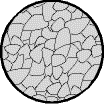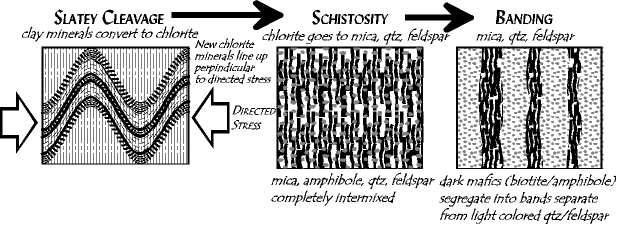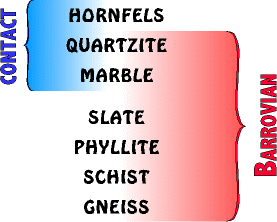
For Elementary School Teachers
METAMORPHIC TEXTURES AND COMPOSITIONS

Metamorphic Rock Texture
The new metamorphic textures are of two types, granular (also non-foliated) where the grains are equidimensional, and foliated where the minerals are layered .
Granular rocks are usually uniform in composition; they are all one mineral (e.g. quartz = quartzite, calcite = marble; exception = hornfels) so the minerals do not segregate into layers - like the picture to the right. (We must be careful not to confuse mineral layering with color banding; in some rocks color banding looks superficially like mineral layering, but color banding without mineral layering is not foliation; for example in this serpentinite.)
Foliated textures result when the new metamorphic minerals (many of which are platy micas such as biotite and muscovite) line up producing a distinct layering in the rock. The layering produces three distinctly different looking rocks, those with slaty cleavage (e.g. slate), schistosity (e.g. schist), and mineral banding (or gneiss texture). Metamorphic rocks are identified on these textures (click image for large version, or go to Metamorphic Texture for more details).
 One source of confusion is that we have both texture names and rock names, and although they often refer to the same thing, there are exceptions. The table below shows all the relationships. Since texture names and rock names do not line up perfectly it is important to distinguish them, but from this point on we will refer to everything by rock names.
One source of confusion is that we have both texture names and rock names, and although they often refer to the same thing, there are exceptions. The table below shows all the relationships. Since texture names and rock names do not line up perfectly it is important to distinguish them, but from this point on we will refer to everything by rock names. 
Metamorphic Rock Composition
Metamorphism is the alteration of a parent rock into a metamorphic rock. There are as many parent rocks as there are igneous, sedimentary, and metamorphic rocks, since any of these can be metamorphosed.
But, the simplest way to examine compositional changes during metamorphism is to start with the three end products of the simple model for sedimentary rocks, shown in the illustration below (click picture for full model). These weathering products are also the most common sedimentary rocks and form a very large percentage of the metamorphic rocks we see.
These three end products (attractors) in the sedimentary model (quartz sandstone, shale, and limestone) become the three parent rocks of metamorphism. All the metamorphic rocks discussed here, and included in the identification key (see below) come from these three parents.
The Changes We See
Compositionally simple sedimentary rocks, such as quartz sandstone and limestone (calcite) do not change composition with metamorphism - their chemistry is too simple. Quartz remains quartz, and calcite remains calcite. The rocks do recrystallize, though, forming granular rocks with fused grains; the rocks quartzite and marble. It does not matter by what process you metamorphose quartz sandstone and limestone, their composition does not change, and they produce the same kind of metamorphic rock.
Rocks with a more complex chemical composition, such as shale (the mineral clay), however, undergo many compositional, and textural changes. Shale produces the greatest diversity of metamorphic rocks, so many changes in fact that it is sometimes hard to believe they could all come from the same parent. We can see this in the chart below where sedimentary shale turns into slate, then phyllite, then schist, then gneiss. These rocks look so different that it can be hard to imagine they are all derived from the same shale parent (and this does not even include the hornfels produced when shale is contact metamorphosed).

Note that we keep referring here to the mineral composition of the rocks, and will make some use of mineral composition in the key to identifying the rocks. If you are working with elementary school students it is easy to introduce them to the few minerals needed, but you can also work with just the general appearances of the rocks.
Rocks are identified by making a series of decisions about their properties, such as texture, composition, hardness, etc. This requires the ability to observe and recognize these properties - one of the skills of science that must be learned for each group of rocks.
The Key to Common Metamorphic Rocks allows someone to identify a rock based on its properties. We are able to do this because the properties do not overlap completely. You can see this on the key through the color coding for the properties. None of the colors overlap completely. [Note this key does print legibly in black and white.]
Go to Simple Metamorphic Identifiction Keys and Charts for suggestions on using the key with students.
KINDS OF METAMORPHISM
Although there are basically five kinds of metamorphism, most introductions to metamorphism focus on just two: Barrovian (" regional" ) and Contact. We examine each of these below.Barrovian Metamorphism
 Barrovian metamorphism takes place during mountain building events when very large areas of sedimentary rocks are buried, squeezed, and heated. Sometimes the metamorphism occurs just because the burial is deep enough, but often it is also associated with major igneous intrusions that supply most of the heat. For example, the small sketch to the right shows a collision between two continents Clicking on it will take you to a larger drawing of a continent-continent collision showing regions of Barrovian metamorphism.
Barrovian metamorphism takes place during mountain building events when very large areas of sedimentary rocks are buried, squeezed, and heated. Sometimes the metamorphism occurs just because the burial is deep enough, but often it is also associated with major igneous intrusions that supply most of the heat. For example, the small sketch to the right shows a collision between two continents Clicking on it will take you to a larger drawing of a continent-continent collision showing regions of Barrovian metamorphism. Barrovian metamorphism produces both textural changes and compositional changes in the rock. The compositional changes take place because sedimentary minerals are stable only at the earth's surface. As they become buried the sedimentary minerals become unstable and transform into new metamorphic minerals. For example, clay goes to chlorite, and chlorite eventually goes to quartz, feldspar, and mica, as well as other minerals. At the upper end of metamorphism the rock melts and becomes igneous.
But the texture of the rock also changes during metamorphism. The rocks become foliated, that is the texture sequence of slaty cleavage to schsitosity, to banded, or the rock sequence slate to phyllite to schist to gneiss.
Thus, metamorphic rocks not only tell us the kind of metamorphism, they are also a measure of the intensity of metamorphism. The closer we get to the source of heat and pressure the more altered the rock becomes.
Contact Metamorphism (click image for enlargement)
 Contact metamorphism occurs in the " country rock" (the rock intruded by and surrounding an igneous intrusion). Rocks are " baked" into a ceramic from heat escaping from intrusives, often enhanced by hot fluids. However, unlike Barrovian metamorphism, pressure is not a significant factor in the contact process, especially directed pressure. Without directed pressure foliation does not develop. So, the clay (shale) which in Barrovian metamorphism develops a strong foliation (slate, phyllite, schist, gneiss) in contact metamorphism develops a granular texture (the rock hornfels). The analogy is putting a clay pot in a kiln; the clay is simply baked.
Contact metamorphism occurs in the " country rock" (the rock intruded by and surrounding an igneous intrusion). Rocks are " baked" into a ceramic from heat escaping from intrusives, often enhanced by hot fluids. However, unlike Barrovian metamorphism, pressure is not a significant factor in the contact process, especially directed pressure. Without directed pressure foliation does not develop. So, the clay (shale) which in Barrovian metamorphism develops a strong foliation (slate, phyllite, schist, gneiss) in contact metamorphism develops a granular texture (the rock hornfels). The analogy is putting a clay pot in a kiln; the clay is simply baked. Contact metamorphism can occur next to any igneous intrusion, although it is most easily seen next to smaller intrusions. The intensity of metamorphism decreases with distance from the intrusion, until at some distance away the rock is unaltered country rock. However, large intrusions such as batholiths usually alter the country rock so much that other styles of metamorphism override the contact metamorphism.
The Relationships Between Rock and Process
 One final observation. It would be nice if there was a simple relationship between the processes of metamorphism and the rocks produced. For example, if all schist rocks were produced by the same kind of metamorphism. Or, if a particular kind of metamorphism produced rocks not found in any other kind of metamorphism. Unfortunately, such simple relationships do not exist. True, some rocks are confined to one kind of metamorphic process, but other rocks result from more than one kind of metamorphism. Eventually these relationships have to be learned, but they can be easily summarized in the table to the right for this simple classification.
One final observation. It would be nice if there was a simple relationship between the processes of metamorphism and the rocks produced. For example, if all schist rocks were produced by the same kind of metamorphism. Or, if a particular kind of metamorphism produced rocks not found in any other kind of metamorphism. Unfortunately, such simple relationships do not exist. True, some rocks are confined to one kind of metamorphic process, but other rocks result from more than one kind of metamorphism. Eventually these relationships have to be learned, but they can be easily summarized in the table to the right for this simple classification.Observe that hornfels, quartzite, and marble are contact metamorphic rocks, but that hornfels is the only strictly contact metamorphic rock. And, note that quartzite and marble can be formed by both contact and Barrovian metamorphism.
One lesson might be that simple parent rocks undergo simple metamorphism, regardless of the kind or intensity of metamorphism. Another lesson is, quartzite and marble cannot tell you the kind of metamorphism, although hornfels, slate, phyllite, schist, and gneiss can.
Associated with this page:
Go on to more detailed pages
